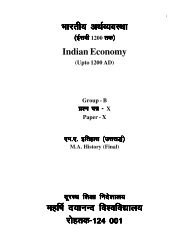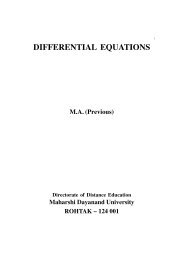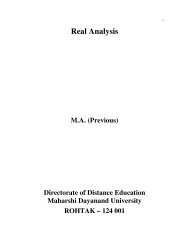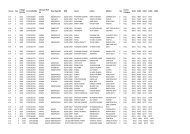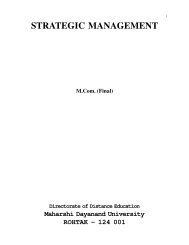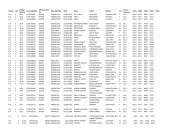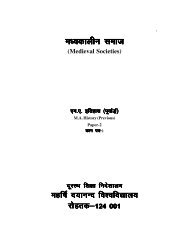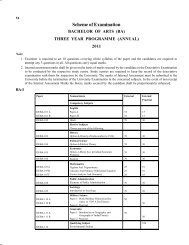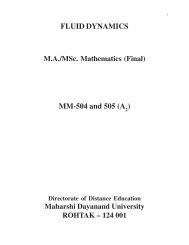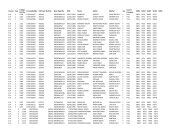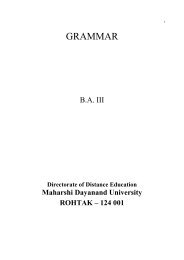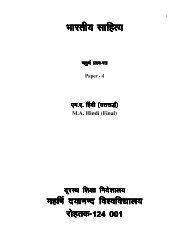Advanced Abstract Algebra - Maharshi Dayanand University, Rohtak
Advanced Abstract Algebra - Maharshi Dayanand University, Rohtak
Advanced Abstract Algebra - Maharshi Dayanand University, Rohtak
You also want an ePaper? Increase the reach of your titles
YUMPU automatically turns print PDFs into web optimized ePapers that Google loves.
UNIT-V<br />
131<br />
As F<br />
= p dΘ F ≅ Z p i, each α i ∈ F can be chosen p ways. Hence that total number of ways in which an<br />
element in k can be defined in p n ways. So<br />
Theorem 6.<br />
1. Let k be a finite field with p n elements. Then k is the splitting of the polynomial x<br />
p n − x<br />
subfield of k.<br />
2. Two finite fields are isomorphic<br />
.<br />
they have the same number of elements.<br />
over the prime<br />
3. Let k be a finite field with p n elements. Then each subfield of k has p m elements for some divisor m of<br />
n. Conversely, for each +ve divisor m of n<br />
a unique subfield of k with<br />
elements.<br />
4. V prime p and V positive integer n, ∃ a field with<br />
Proof:<br />
elemetns.<br />
1. Θ k has<br />
elements, then k*, the multiplicative group of k has p n –1 elements. Hence for any<br />
∗<br />
−<br />
x ∈k ⊂ k, x pn 1<br />
= 1 , so p<br />
x n = x V<br />
. The polynomial<br />
has atmost p n roots<br />
and so its roots must be precisely the elements of k. Hence k is the splitting field of f xbgover the<br />
prime subfield of k.<br />
2. is the corollary of (1). Let and k 2<br />
be two finite fields with p n elements, containing prime subfields<br />
F 1<br />
and F 2<br />
respectively. But F1 ≅ Z<br />
p<br />
≅ F2<br />
. By (1), k 1<br />
and k 2<br />
are splitting fields x<br />
p n − x over isomorphic<br />
⇔∃<br />
mk x<br />
p m<br />
n ∈ =<br />
kp.<br />
n p<br />
f n<br />
1<br />
≅ k2 ⇔ k 1 = k2<br />
.<br />
n<br />
pn p<br />
xf( ( x) ) = x −1 n<br />
−<br />
x1<br />
. fields F 1<br />
and F 2.<br />
Hence from unit (IV),<br />
p m 3. Let F 1<br />
be the prime subfield of k. Let k 1<br />
be a subfield of k. Then<br />
n = k: F1 = k: k1 k1: F1 k1:<br />
F1<br />
n<br />
Let k1: F1<br />
= m,<br />
so any subfield k 1<br />
of k must have p m elements such that m n .<br />
–1 is a divisor of p n − 1 and so q(x) =<br />
Conversely, suppose<br />
x pm − 1<br />
− 1 is a divisor of<br />
for some positive integer m. Then<br />
p<br />
As k is the splitting field of x n − x = xf ( x) over F 1<br />
. We know<br />
p<br />
{ } n<br />
is a subfield of k and<br />
that a ∈ k:<br />
a = a<br />
has distinct roots. So k must contain all p m<br />
distinct roots of xg(x). Hence these roots form a subfield of k. Moreover, any other subfield with p m elements<br />
p<br />
must be a splitting field of xg( x) = x m<br />
− x.<br />
Hence there exists unique subfield of k with p m elements.<br />
p<br />
4. Let k be the splitting field of f ( x) = x n<br />
− x over its prime subfield isomorphic to Z p . Now<br />
n<br />
n<br />
e j d i<br />
p<br />
p −1<br />
x − x = x x − 1 and p × p n − 1 . p<br />
So it is easy to see that f ( x) = x n<br />
− x has distinct roots.<br />
p<br />
{ a ∈ k:<br />
a n<br />
= a} is a subfield of k and so set of all roots of f(x) is a subfield of k. Hence k consists of



